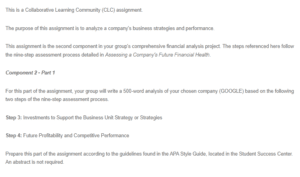Business Strategies and Performance Analysis – Google
Google is a brand, which performs with the vision of organizing information and making it accessible to millions of users worldwide. It evolves with the changing times to stay at par with the new lifestyles, generations, and technology. It segments its products based on demographics, psychographics, and geography, to cater to all people’s needs in the technological market. The company prides itself on its value-based approach to make life easier for its users (Gerth, 2019). Despite being an achiever, Google’s primary goal is to intensify its market position and do this, and it takes part in various investments to support its business strategies.
Foremost, Google focuses on mergers and acquisitions to amplify its market search. For instance, in June 2019, the company added business intelligence to its tools of data analytics (Mutanga & Kumar, 2019). It also acquired Alooma, a company based in Israel, to enhance big data assets and simplify its cloud migration. Also, it developed a customer service startup, Onward, which was after it had set up its call center. Additionally, in September 2016, it invested in natural language technology by acquiring API, which was meant to enable developers to build conversational bots that could enhance better customer service (Boroumand et al., 2018). The company recently invested in its technology and market search by offering machine learning, artificial intelligence, natural language, cloud migration, and big data. The company also adopted NLP and ML, making it a better space for bettering customer engagements and enriching their experience on the internet.
Considering the company’s strategic partnerships over the years, it is evident that it is promoting its existing services and advancing to cater to the needs of the next generations and technologies and products. For instance, in 2019, the company partnered with Walmart to facilitate voice-driven grocery shopping (Gerth, 2019). In 2017, it partnered with Audi and Volvo to create an operating system that was beyond smartphones and was futuristic for cars. The company has formed partnerships with various partners and is focused on expanding to vast markets and supply products and services to current and potential customers using advanced technology.
Also, its competitive advantage gives it dominance as it is the most used search engine worldwide, with over 80% of the search market (Srinivasan, 2020). Google has developed a good infrastructure that enhances efficiency and a fast search engine to maintain this competitive advantage. Its competitive advantage is linked to the fact that it has created its storage systems and servers, which support its search (Klimmek et al., 2021). It uses its fast speed as its competitive advantage to keep its customers coming back and attracting potential customers. Though the search results may be different, the user can change the keywords and conduct another search within the shortest time.
The company gives fast results and provides other services such as google maps, google toolbar, and Google news (Brickley, Burgess & Noy, 2019). Google maps help users navigate, while the toolbar enables users to open other search bars and conduct different searches without closing the home page. Such features give the company an edge and competitive advantage over its competitors like Yahoo. With this competitive advantage, it can make more profits in the future, as it commands more market share, which translates into profits in the future.
References
Boroumand, A., Ghose, S., Kim, Y., Ausavarungnirun, R., Shiu, E., Thakur, R., … & Mutlu, O. (2018, March). Google workloads for consumer devices: Mitigating data movement bottlenecks. In Proceedings of the Twenty-Third International Conference on Architectural Support for Programming Languages and Operating Systems (pp. 316-331).
Brickley, D., Burgess, M., & Noy, N. (2019, May). Google Dataset Search: Building a search engine for datasets in an open Web ecosystem. In The World Wide Web Conference (pp. 1365-1375).
Gerth, K. M. (2019). Creating sustainable competitive advantage in the German B2B lending business: the case study of Google LLC (Doctoral dissertation).
Klimmek, M., Hermes, S., Schreieck, M., & Krcmar, H. (2021). Platform Roles in a Multi-Platform Strategy: Insights from Google.
Mutanga, O., & Kumar, L. (2019). Google earth engine applications.
Srinivasan, D. (2020). Why Google Dominates Advertising Markets. Stan. Tech. L. Rev., 24, 55.
ORDER A PLAGIARISM-FREE PAPER HERE
We’ll write everything from scratch
Question 

Business Strategies and Performance Analysis – Google
This is a Collaborative Learning Community (CLC) assignment.
The purpose of this assignment is to analyze a company’s business strategies and performance.
This assignment is the second component in your group’s comprehensive financial analysis project. The steps referenced here follow the nine-step assessment process detailed in Assessing a Company’s Future Financial Health.
Component 2 – Part 1
For this part of the assignment, your group will write a 500-word analysis of your chosen company (GOOGLE) based on the following two steps of the nine-step assessment process.
Step 3: Investments to Support the Business Unit Strategy or Strategies
Step 4: Future Profitability and Competitive Performance
Prepare this part of the assignment according to the guidelines found in the APA Style Guide, located in the Student Success Center. An abstract is not required.
